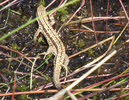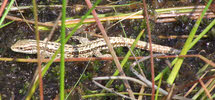

The common lizard is a widespread species which is the most northerly dwelling reptile. It has a long tail and short legs with a rounded head, the tail can be twice the length of the body. Colour and markings vary a great deal; normally brown, but black, grey and green examples have all been seen. The males have coloured bellies while females normally have white or cream bellies with over-all length being not more than 15cm. It is an agile and fast reacting animal speeding away if disturbed.
 On colder days the lizard can be often seen basking in sunny places to raise its body temperature from 15 degrees (on waking) to 30 degrees (hunting temperature). In warmer climates it is active all year round but in colder environments (such as the UK) they hibernate from September to the end of February .Mating season is in late April/ early May and as an adaptation to colder environments the lizard does lay eggs but has the young develop inside the female for their first 3 months emerging as black 3 cm long juveniles. Some populations in warmer locations are egg laying and the two types can interbreed but not without risk of birth abnormalities. This variation in reproduction and hibernation shows a remarkable ability to adapt to various environments which contributes greatly to the species' success
On colder days the lizard can be often seen basking in sunny places to raise its body temperature from 15 degrees (on waking) to 30 degrees (hunting temperature). In warmer climates it is active all year round but in colder environments (such as the UK) they hibernate from September to the end of February .Mating season is in late April/ early May and as an adaptation to colder environments the lizard does lay eggs but has the young develop inside the female for their first 3 months emerging as black 3 cm long juveniles. Some populations in warmer locations are egg laying and the two types can interbreed but not without risk of birth abnormalities. This variation in reproduction and hibernation shows a remarkable ability to adapt to various environments which contributes greatly to the species' success
Habitat
 The common lizard's range extends throughout central, northern (including the Arctic Circle) and some parts of southern Europe although it is rare around the Mediterranean and not found near the Black sea, it is also one of the few reptiles found in Ireland. It is also found across central Asia and in Japan. It is well adapted to cold conditions and has been found above 3,000ft in the Alps, preferring wet areas near water but in the colder areas it prefers woodlands, gardens and moor land.
The common lizard's range extends throughout central, northern (including the Arctic Circle) and some parts of southern Europe although it is rare around the Mediterranean and not found near the Black sea, it is also one of the few reptiles found in Ireland. It is also found across central Asia and in Japan. It is well adapted to cold conditions and has been found above 3,000ft in the Alps, preferring wet areas near water but in the colder areas it prefers woodlands, gardens and moor land.
Prey
The common lizard eats small insects, worms and spiders, larger prey are held in its jaws and shaken before being swallowed whole. It is a protected species in the UK under the Wildlife and Countryside act making it an offence to kill injure or sell a common lizard.